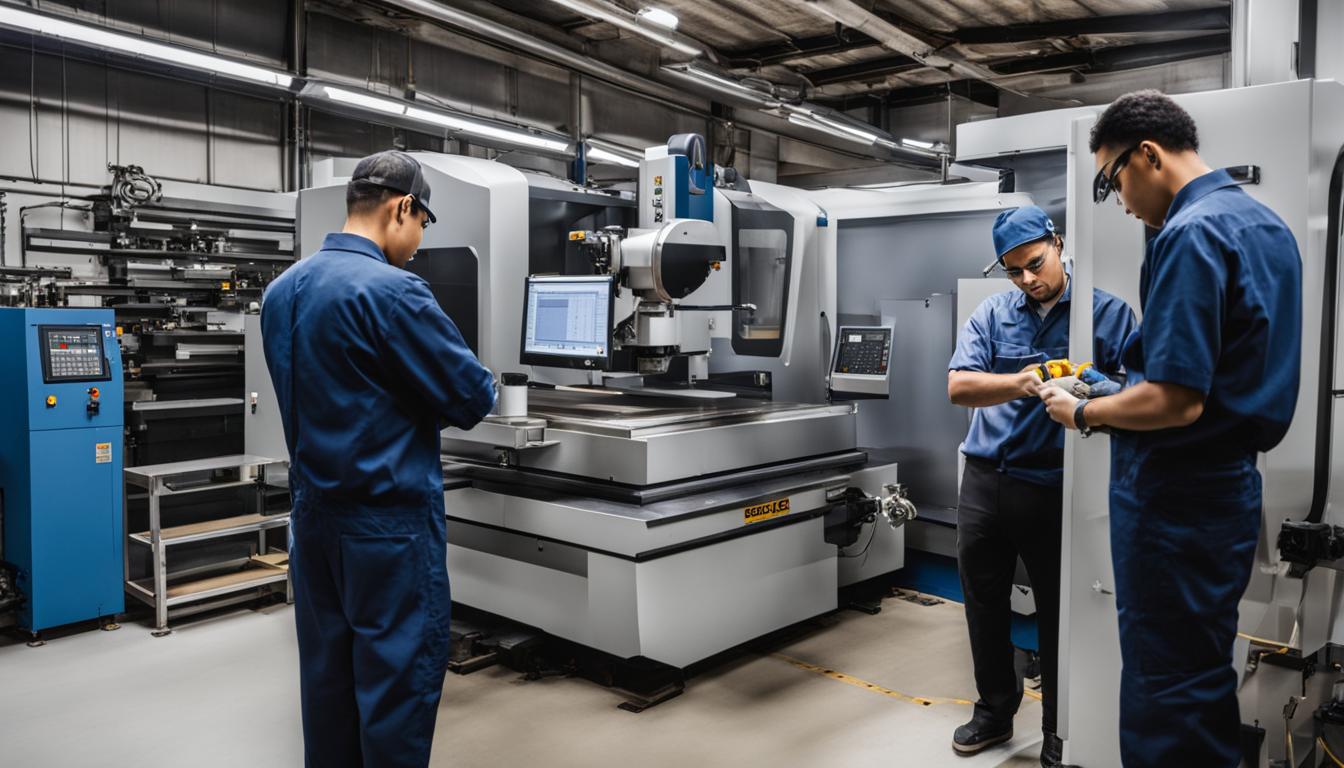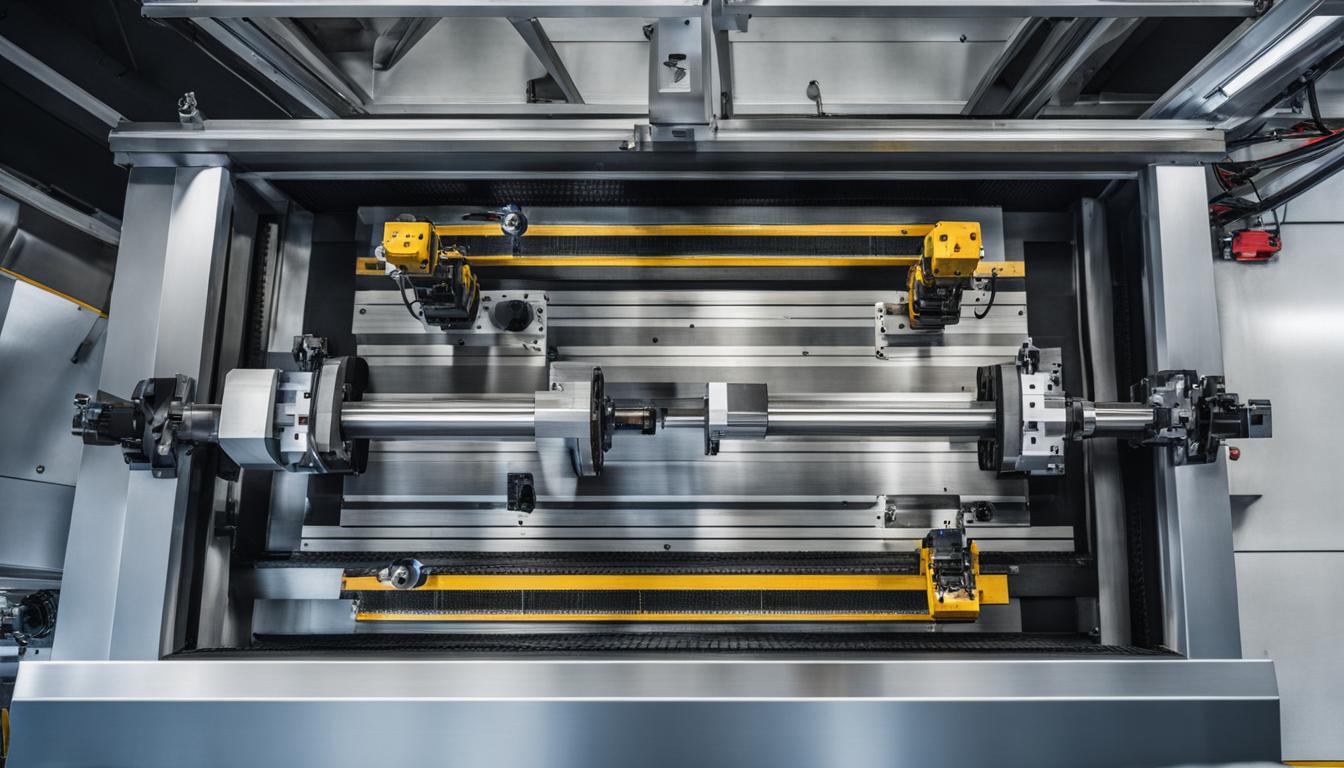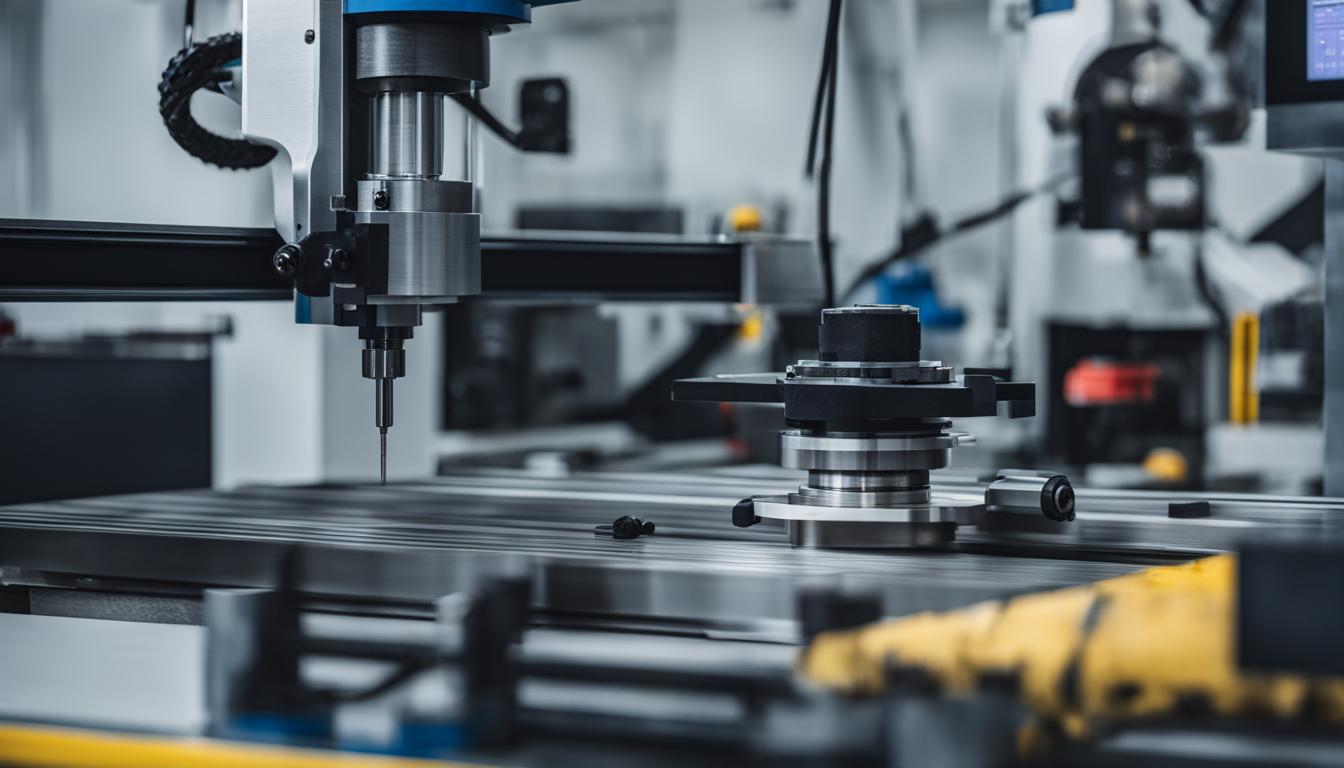In the field of CNC machining, quality control measures play a critical role in ensuring precision, consistency, and high-quality outcomes. These measures are implemented throughout and after the machining process to meet customer demands and industry regulations. By maintaining strict quality control standards, manufacturers can deliver products that meet or exceed customer expectations, reduce costs, and improve overall efficiency.
- Quality control measures are essential in CNC machining to maintain precision, consistency, and high-quality outcomes.
- Implementing quality control measures helps meet customer demands and comply with industry regulations.
- By ensuring consistency and quality in the machining process, manufacturers can reduce costs and improve efficiency.
- Effective communication with customers is vital for quality control and customer satisfaction.
- Inspecting raw materials and utilizing on-machine inspections are important steps in maintaining quality control in CNC machining.
The Importance of Quality Control in CNC Machining
Quality control is a crucial aspect of CNC machining that plays a significant role in ensuring the production of high-quality products. By implementing effective quality control measures, manufacturers can adhere to industry regulations, reduce costs, and improve overall efficiency.
One of the primary reasons why quality control is essential in CNC machining is to meet industry regulations. Different industries have specific standards and requirements that products must adhere to. By implementing quality control measures, manufacturers can ensure their products meet these regulations, avoiding any legal issues and potential financial losses.
Moreover, quality control helps maintain consistency in product quality. Consistent production is vital for establishing a company’s reputation and image in the market. Customers expect products of consistent quality, and by implementing quality control measures, manufacturers can meet these expectations, ensuring customer satisfaction and loyalty.
Furthermore, quality control measures contribute to cost reduction and efficiency improvement. By identifying and addressing any issues or errors early on in the machining process, manufacturers can avoid wastage of materials and resources. This results in cost savings and improved overall efficiency, as defective products are minimized, and production time is optimized.
Table: Benefits of Quality Control in CNC Machining
| Benefits | Description |
|---|---|
| Adherence to industry regulations | Ensures compliance with specific standards and requirements set by the industry |
| Consistency in product quality | Maintains a reputation for delivering products of consistent high quality |
| Cost reduction | Avoids wastage of materials and resources, resulting in cost savings |
| Efficiency improvement | Optimizes production time and reduces the likelihood of defects or errors |
| Customer satisfaction | Ensures products meet customer expectations, leading to increased satisfaction and loyalty |
Communication with Customers for Quality Control in CNC Machining
In the CNC machining industry, effective communication with customers plays a crucial role in ensuring quality control throughout the manufacturing process. By maintaining clear and open lines of communication, manufacturers can better understand customer requirements and specifications, leading to higher levels of customer satisfaction.
One key aspect of communication with customers is keeping them informed about the progress of their project. Providing regular updates and milestones can help manage expectations and address any concerns or changes in specifications promptly. This not only helps prevent misunderstandings but also allows for early identification and resolution of any potential issues that may arise during the CNC machining process.
Additionally, video calls or virtual meetings can be utilized to enhance communication and provide visual demonstrations of the progress and quality of the CNC machined parts. This allows customers to have a better understanding of the product and provides an opportunity for real-time feedback and adjustments, further ensuring that the final product meets their requirements and specifications.
Satisfaction-guaranteed Customer Communication Strategies:
- Regular updates and milestone reporting
- Video calls and virtual meetings for visual demonstrations and real-time feedback
- Prompt response to customer inquiries and changes in specifications
- Transparent and honest communication to manage customer expectations
To summarize, effective communication with customers is a vital quality control measure in CNC machining. By maintaining open lines of communication, providing regular updates, and utilizing video calls, manufacturers can ensure that customer requirements and specifications are met, leading to higher levels of customer satisfaction. This, in turn, contributes to the production of high-quality CNC machined parts and fosters long-term business relationships.
Ensuring Consistency in CNC Machining
Consistency plays a crucial role in CNC machining when it comes to maintaining high-quality outcomes and managing production costs. By implementing effective quality control measures, manufacturers can ensure that every product is consistently manufactured to meet the required standards, reducing the risk of defects and errors.
To achieve consistency in CNC machining, it is essential to establish standardized processes and procedures that are followed consistently across the production line. This includes using calibrated tools and equipment, maintaining proper machine parameters, and adhering to strict quality guidelines. By doing so, manufacturers can minimize variations in product quality and achieve consistent results.
Consistency not only improves the overall quality of the products but also helps in managing production costs. When the manufacturing process is consistent and predictable, it becomes easier to identify and address any deviations or issues that may arise. This proactive approach helps prevent wastage, rework, and the need for costly repairs, ultimately leading to better cost management and improved profitability.
| Benefits of Ensuring Consistency in CNC Machining: | |
|---|---|
| 1. High-Quality Products | Consistency ensures that every product meets the required standards and customer expectations. |
| 2. Reduced Defects and Errors | A consistent manufacturing process minimizes the occurrence of defects and errors in the final products. |
| 3. Efficient Production | Consistency improves efficiency by reducing the need for rework, repairs, and unnecessary adjustments. |
| 4. Effective Cost Management | Managing production costs becomes easier when the process is consistent and variations are minimized. |
In conclusion, ensuring consistency in CNC machining is essential for maintaining high-quality outcomes, managing production costs, and meeting customer expectations. By implementing effective quality control measures and establishing standardized processes, manufacturers can minimize variations, reduce defects, and improve overall efficiency. Consistency not only benefits the company by improving profitability but also enhances the reputation and customer satisfaction.
Completing Inspections During Running of CNC Machined Parts
Inspections play a crucial role in ensuring the quality and accuracy of CNC machined parts. By conducting inspections during the running of the parts, manufacturers can identify and address any problems or adjustments that need to be made, leading to better overall outcomes. Early identification of issues allows for timely adjustments and prevents the production of defective or out-of-tolerance parts. This approach helps maintain consistency, precision, and adherence to customer specifications throughout the machining process.
During the running of CNC machined parts, inspections enable manufacturers to monitor key factors such as dimensions, surface finish, and material integrity. By utilizing advanced measurement tools and techniques, deviations from the desired specifications can be detected and corrected in real-time. This proactive approach minimizes the risk of producing non-conforming parts and reduces the need for rework or scrap, resulting in cost savings for manufacturers.
Furthermore, conducting inspections during the running of CNC machined parts allows for tolerance adjustments if necessary. By closely monitoring the machining process and inspecting the parts at various stages, manufacturers can make fine-tuned adjustments to ensure that the final products meet the required tolerances. This proactive approach helps prevent any potential deviations from the specified measurements, resulting in high-quality products that satisfy customer requirements.
In conclusion, completing inspections during the running of CNC machined parts is a critical quality control measure. It enables early identification of problems, facilitates timely adjustments, and ensures the production of high-quality parts that meet customer specifications. By implementing this practice, manufacturers can enhance their precision, reduce costs, and achieve consistent and satisfactory outcomes in CNC machining.
Compliance with Industry Regulations for CNC Machining Quality Control
Ensuring compliance with industry regulations is a critical aspect of quality control in CNC machining. Adhering to these regulations and industry standards helps prevent financial losses and bottlenecks in the manufacturing process. By implementing robust quality control systems that meet regulatory requirements, manufacturers can minimize the risk of errors, defects, and non-compliance.
Compliance with industry regulations in CNC machining involves adhering to specific guidelines and standards set by relevant authorities or organizations. These regulations may encompass various aspects, such as material specifications, dimensional tolerances, surface finishes, and performance requirements. By following these regulations, manufacturers can ensure that their products meet the necessary quality standards and are safe for use in various applications.
Non-compliance with industry regulations can have severe consequences for manufacturers. It can lead to financial losses due to the production of defective or non-conforming parts and potential legal liabilities. Additionally, non-compliance can cause bottlenecks in the manufacturing process, as products may need to be reworked or scrapped entirely. This can disrupt the production schedule and delay delivery to customers.
By proactively implementing quality control measures that comply with industry regulations, manufacturers can minimize the risk of financial losses and bottlenecks. It also helps ensure that customers receive high-quality products that meet their requirements and adhere to industry standards. Compliance with regulations is an essential aspect of maintaining a competitive edge in the CNC machining industry and building a reputation for reliability and quality.
| Benefits of Compliance with Industry Regulations | Consequences of Non-Compliance |
|---|---|
|
|
Choosing the Right CNC Machine for Quality Control
When it comes to quality control in CNC machining, selecting the right machine is paramount. The choice of machine can significantly impact precision, error prevention, and overall production efficiency. Therefore, manufacturers must carefully consider the machine’s capabilities and specifications to ensure high-quality outcomes.
One crucial factor to consider is the machine’s axis count. Machines with higher axis counts are generally more capable of handling complex tasks with greater precision. They offer increased flexibility and accuracy, reducing the likelihood of errors during the machining process. By utilizing a CNC machine with the appropriate axis count for the task at hand, manufacturers can effectively prevent errors and maintain the desired level of quality.
Another important consideration is the machine’s overall build quality. Machines manufactured by reputable brands with a proven track record of excellence can provide greater confidence in their performance and reliability. Investing in a high-quality machine helps minimize the risk of malfunctions or inconsistencies that may compromise the quality of the final product.

Benefits of Choosing the Right CNC Machine:
- Enhanced precision and accuracy
- Reduced error rates
- Improved efficiency in the machining process
- Optimized workflow and production output
- Higher customer satisfaction due to consistent quality
In summary, selecting the right CNC machine is a critical aspect of quality control in CNC machining. By considering factors such as axis count and build quality, manufacturers can ensure that they are equipped with the necessary tools to achieve precision, error prevention, and high-quality outcomes.
Inspecting Raw Materials for Quality Control in CNC Machining
Quality control in CNC machining begins with the inspection of raw materials. Adequate inspection of raw materials is essential to ensure that only high-quality materials are used in the machining process. Even the most precise CNC machines cannot compensate for poor-quality materials, so thorough inspection is a crucial step.
During the raw material inspection, various factors are assessed to determine the material’s quality. This includes checking for defects, fractures, weak spots, and any other abnormalities that could affect the final product’s performance. By identifying and addressing these issues at the raw material stage, wastage can be minimized, and the production of high-quality finished products can be ensured.
To conduct a thorough raw material inspection, manufacturers utilize various tools and techniques. These may include visual inspection, non-destructive testing methods such as ultrasonic testing or magnetic particle inspection, and measuring instruments to assess material properties like hardness or tensile strength. The inspection process may vary depending on the type of material being used, with specific standards and guidelines set for each material type.
| Benefits of Raw Material Inspection in CNC Machining |
|---|
| 1. Wastage Prevention: By inspecting raw materials for defects and abnormalities, manufacturers can prevent the use of subpar materials, reducing wastage in the production process. |
| 2. Quality Assurance: Ensuring that only high-quality materials are used guarantees the production of high-quality finished products, enhancing customer satisfaction and reducing the likelihood of product failures. |
| 3. Cost Efficiency: By preventing the use of faulty or substandard materials, manufacturers can avoid costly rework, rejects, or customer returns, resulting in improved cost efficiency. |
| 4. Compliance with Standards: Raw material inspection helps ensure compliance with industry standards and regulations, ensuring that the final products adhere to required specifications and performance criteria. |
Overall, inspecting raw materials for quality control in CNC machining is an essential step in the manufacturing process. It helps prevent wastage, ensures the use of high-quality materials, and ultimately contributes to the production of reliable and high-performing finished products.
Implementing On-Machine Inspection for CNC Machining Quality Control
On-machine inspection is a crucial component of quality control in CNC machining. By utilizing machine tool probing systems, manufacturers can conduct real-time inspections of the product while it is being machined. This enables prompt identification and correction of any issues, leading to error prevention and improved overall product quality.
The on-machine inspection process involves attaching probing systems to CNC machines, which then measure and analyze the product’s dimensions, surface finish, and overall quality. These measurements are compared to the specified tolerances, allowing any deviations or potential errors to be detected at an early stage.
Benefits of On-Machine Inspection
Implementing on-machine inspection offers several benefits in CNC machining quality control:
- Real-time detection of errors: On-machine inspection allows for immediate identification of any issues or deviations from the desired specifications. This enables timely corrective actions to be taken, preventing the production of defective parts.
- Enhanced accuracy: By conducting inspections during the machining process, on-machine inspection ensures that measurements are taken in the same environmental conditions as the machining itself. This improves accuracy and eliminates potential errors caused by temperature variations or material accumulation.
- Reduced waste and costs: Catching errors early on through on-machine inspection helps minimize waste by preventing the production of faulty parts. This, in turn, reduces costs associated with rework, scrap, and customer returns.
Overall, implementing on-machine inspection as part of CNC machining quality control processes enhances the efficiency, accuracy, and reliability of the manufacturing process, leading to superior product quality and customer satisfaction.

Multiple Quality Control Methods for CNC Machining Quality Control
Implementing multiple quality control methods is essential in CNC machining to prevent and catch errors throughout the production process. Each method has its strengths and weaknesses, and by combining automated and manual inspections, manufacturers can ensure that no errors go unnoticed.
Automated inspections play a crucial role in quality control. These inspections utilize advanced technologies such as machine vision systems and coordinate measuring machines (CMM) to measure dimensions, detect surface defects, and verify product specifications. These automated tools provide fast and accurate results, allowing for efficient error detection and prevention.
However, relying solely on automated inspections may not capture all types of errors, especially those that require human judgment and expertise. Manual inspections serve as a final checkpoint to validate the quality and precision of CNC machined parts. Skilled inspectors visually examine the parts, perform functional tests, and ensure that they meet customer requirements and specifications.
The Benefits of Utilizing Multiple Quality Control Methods
The integration of multiple quality control methods offers several benefits in CNC machining:
- Comprehensive Error Prevention: By combining automated and manual inspections, manufacturers can identify and prevent errors at different stages of the production process, ensuring high-quality outcomes.
- Enhanced Accuracy: Automated inspections provide precise measurements and data analysis, while manual inspections allow for human judgment and attention to detail.
- Efficiency Improvement: Automated inspections streamline the inspection process, reducing the time and effort required for quality control. Manual inspections focus on critical areas, optimizing resources and minimizing inspection time.
- Customization and Flexibility: Different products and industries may require specific quality control approaches. Utilizing multiple methods allows manufacturers to tailor their quality control processes to meet specific customer and industry requirements.
In conclusion, implementing multiple quality control methods is crucial in CNC machining to ensure error prevention and high-quality outcomes. Automated inspections provide fast and accurate measurements, while manual inspections validate product quality and specifications. By combining these methods, manufacturers can achieve comprehensive quality control and meet customer demands effectively.
Seeking Certified Vendors for CNC Machining Quality Control
When it comes to outsourcing CNC machining processes, one of the key factors to consider is working with certified vendors who prioritize quality control. By partnering with vendors that possess certifications such as ISO 9001, you can ensure that they have met comprehensive quality management requirements. This certification serves as a testament to their commitment to delivering high-quality outcomes.
While ISO 9001 is a widely recognized certification, it’s essential to determine if there are additional certifications specific to your industry. For example, medical-grade products may require vendors with ISO 13485 certification, while automotive parts may necessitate ISO 16949 compliance. These certifications validate the vendor’s ability to adhere to industry-specific quality control standards.
Collaborating with certified vendors offers numerous benefits. Not only does it minimize the risk of errors in the CNC machining process, but it also ensures that the products meet the highest quality standards. By choosing certified vendors, you can have peace of mind knowing that your outsourced CNC machining is in the hands of experienced professionals who prioritize quality control.
